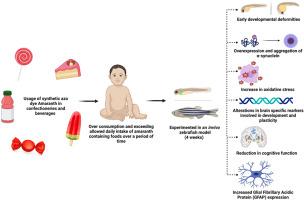Synthetic azo dye amaranth disrupts neuronal plasticity causing alpha-synuclein aggregation and cognitive disability in an in vivo zebrafish model
IF 3.5
3区 医学
Q2 FOOD SCIENCE & TECHNOLOGY
引用次数: 0
Abstract
Amaranth (AMR) or Acid red 27 is a synthetic dye widely used in the textile, pharmaceutical, and food industries. Its high solubility contributes to its environmental persistence as a pollutant, and its widespread use in confectioneries, due to its vibrant color, raises concerns about overexposure, particularly in children. Despite its prevalence, health and ecological risks of AMR remain poorly studied. We investigated the developmental and neurobehavioral effects of AMR in-vivo zebrafish. Assessments of acute and chronic toxicity revealed a dose-dependent increase in mortality and developmental abnormalities. Oxidative stress was evident from ROS accumulation, glutathione depletion (1.14 ± 0.28 U/mg of protein; p = 0.0012), and increased lipid peroxidation (2.80 fold; p < 0.0001) at 100 mg/L. Neurobehavioral analysis revealed cognitive impairment and altered locomotor activity. Molecular analysis using key markers revealed potential disruptions in neuroplasticity. Immunohistochemical analysis revealed elevated GFAP expression (2.42 fold; p < 0.0001) and accumulation of α-synuclein (2.63 fold; p < 0.0001) at 100 mg/L, indicating astrocyte activation and gliosis, suggesting key pathological mechanisms implicated in major neurodegenerative diseases such as Parkinson's disease. These findings highlight AMR's neurotoxic potential at environmentally relevant concentrations, underscoring the urgent need to reassess its regulatory safety limits and environmental impact.

在斑马鱼体内模型中,合成偶氮染料苋菜红破坏神经元可塑性,导致α -突触核蛋白聚集和认知障碍
苋菜红(AMR)或酸性红27是一种合成染料,广泛用于纺织、制药和食品工业。它的高溶解度导致其作为污染物在环境中持续存在,并且由于其鲜艳的颜色,它在糖果中的广泛使用引起了对过度接触的担忧,特别是在儿童中。尽管抗生素耐药性很普遍,但对其健康和生态风险的研究仍然很少。我们研究了AMR对斑马鱼体内发育和神经行为的影响。急性和慢性毒性评估显示死亡率和发育异常呈剂量依赖性增加。氧化应激表现为ROS积累,谷胱甘肽耗竭(1.14±0.28 U/mg);P = 0.0012),脂质过氧化增加(2.80倍;p & lt;0.0001), 100mg /L。神经行为分析显示认知障碍和运动活动改变。使用关键标记的分子分析揭示了神经可塑性的潜在破坏。免疫组化分析显示GFAP表达升高(2.42倍;p & lt;0.0001)和α-synuclein的积累(2.63倍;p & lt;0.0001),表明星形胶质细胞活化和胶质瘤形成,提示与帕金森病等主要神经退行性疾病有关的关键病理机制。这些发现强调了AMR在环境相关浓度下的神经毒性潜力,强调了重新评估其监管安全限制和环境影响的迫切需要。
本文章由计算机程序翻译,如有差异,请以英文原文为准。
求助全文
约1分钟内获得全文
求助全文
来源期刊

Food and Chemical Toxicology
工程技术-毒理学
CiteScore
10.90
自引率
4.70%
发文量
651
审稿时长
31 days
期刊介绍:
Food and Chemical Toxicology (FCT), an internationally renowned journal, that publishes original research articles and reviews on toxic effects, in animals and humans, of natural or synthetic chemicals occurring in the human environment with particular emphasis on food, drugs, and chemicals, including agricultural and industrial safety, and consumer product safety. Areas such as safety evaluation of novel foods and ingredients, biotechnologically-derived products, and nanomaterials are included in the scope of the journal. FCT also encourages submission of papers on inter-relationships between nutrition and toxicology and on in vitro techniques, particularly those fostering the 3 Rs.
The principal aim of the journal is to publish high impact, scholarly work and to serve as a multidisciplinary forum for research in toxicology. Papers submitted will be judged on the basis of scientific originality and contribution to the field, quality and subject matter. Studies should address at least one of the following:
-Adverse physiological/biochemical, or pathological changes induced by specific defined substances
-New techniques for assessing potential toxicity, including molecular biology
-Mechanisms underlying toxic phenomena
-Toxicological examinations of specific chemicals or consumer products, both those showing adverse effects and those demonstrating safety, that meet current standards of scientific acceptability.
Authors must clearly and briefly identify what novel toxic effect (s) or toxic mechanism (s) of the chemical are being reported and what their significance is in the abstract. Furthermore, sufficient doses should be included in order to provide information on NOAEL/LOAEL values.
 求助内容:
求助内容: 应助结果提醒方式:
应助结果提醒方式:


